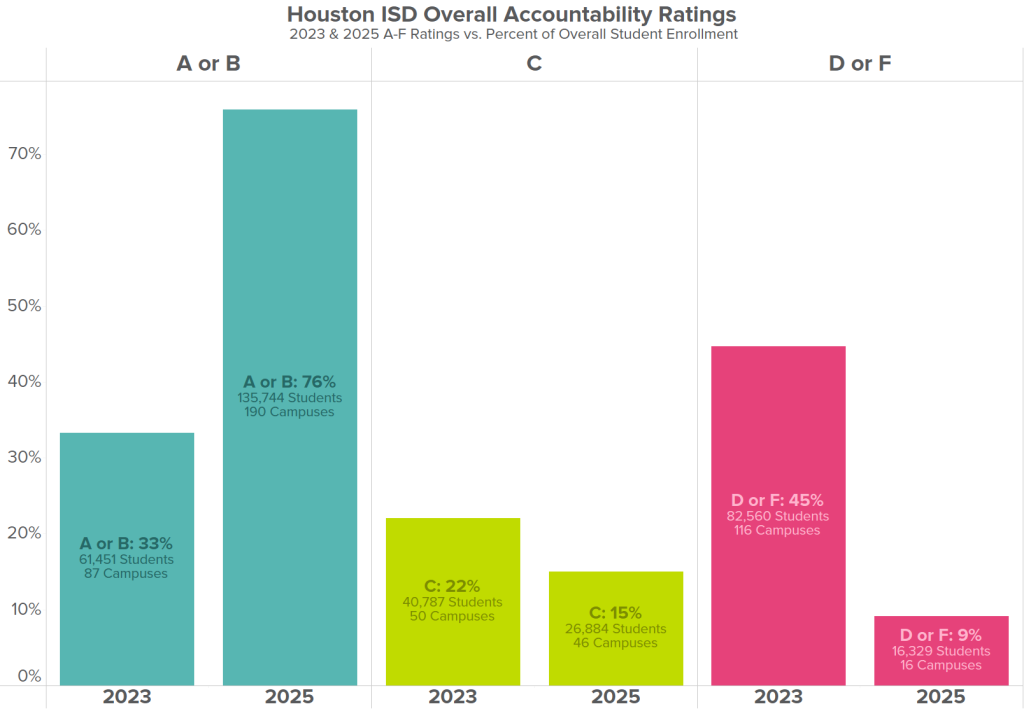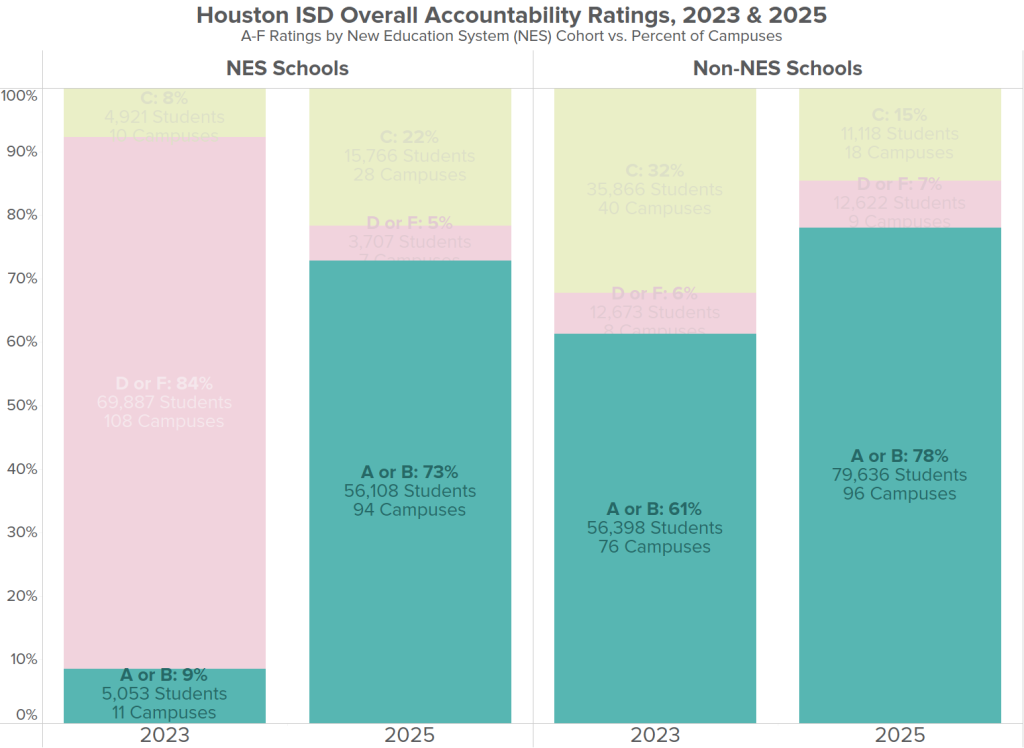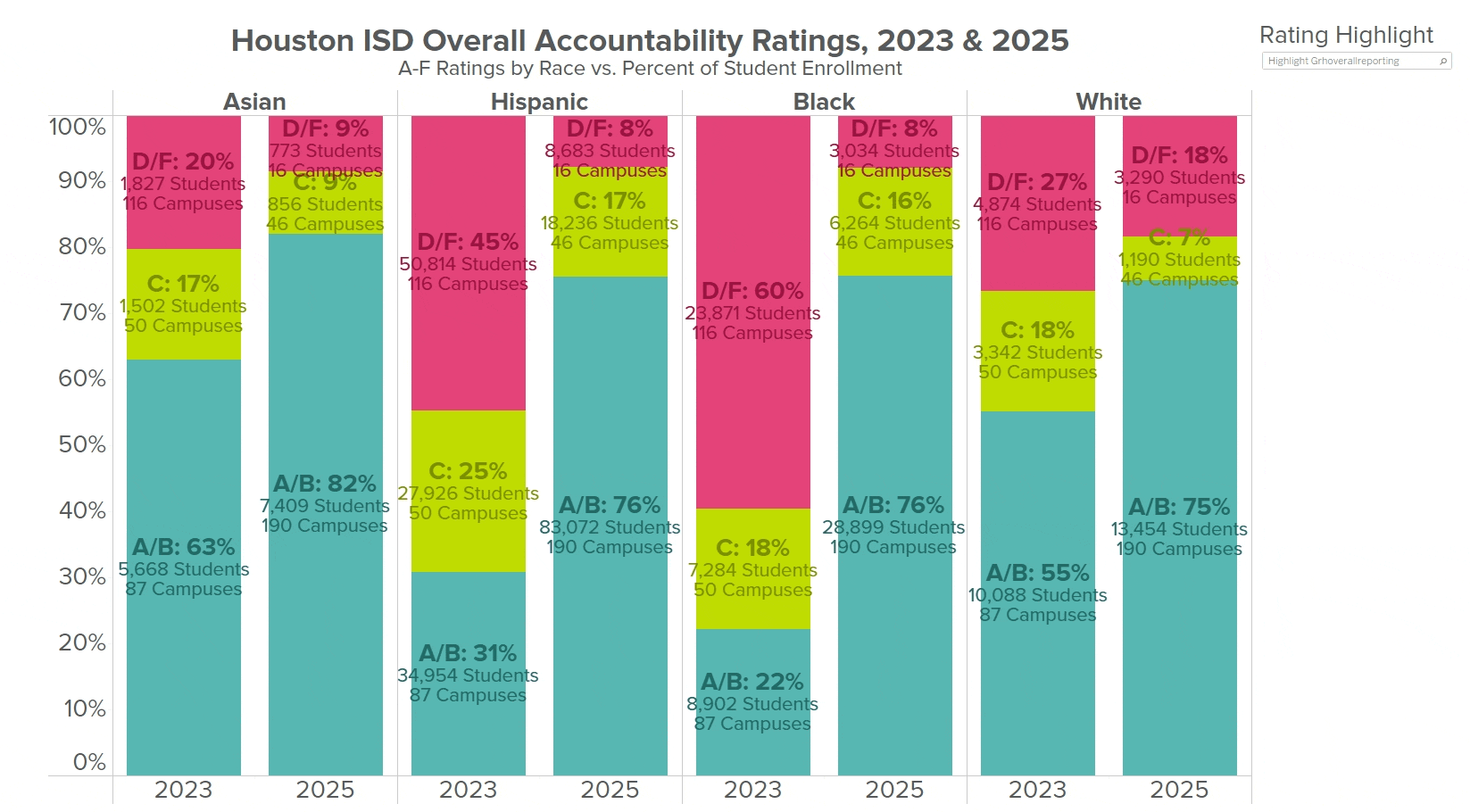On August 15th, the Texas Education Agency (TEA) released A-F school ratings for both the 2023-24 and 2024-25 school years, showing remarkable progress across Houston-area schools. Nearly 145,000 more students now attend A- or B-rated campuses than in 2023, with Houston ISD leading these gains. After a two-year pause, these ratings help families understand how well schools prepare students for graduation and set them on the path to earning a living wage.
Learn more about how A-F ratings are calculated
HISD is the largest school district in Texas, serving nearly 180,000 students and has been under state intervention by the Texas Education Agency (TEA) since 2023. Given this context and the district’s size, understanding HISD’s progress may help identify strategies worth implementing across other districts in our region.
Learn more about how schools in the Houston region performed
Key Findings: 75,000 More HISD Students in High-Rated Schools
In 2025, nearly 136,000 HISD students attended an A- or B-rated campus—an increase of almost 75,000 students compared to 2023. Most progress occurred at campuses implementing the district’s New Education System (NES). Additionally:
- Zero HISD campuses received an F rating, down from 54 campuses in 2023.
- 190 HISD campuses (75%), earned an A or B, up from 87 campuses (34%) in 2023.

While these positive trends should be celebrated, we must consider them alongside other important measures of student success and learning, like participation in advanced coursework, social-emotional learning, extracurricular engagement, and school culture.
New Education System Drives Results
The NES model, introduced during the 2023-24 school year, provides additional resources to the schools that need them the most and aims to close achievement gaps across different student groups. Early student achievement results provide promise, but more work is required to understand which specific factors are driving these improvements and how they are experienced by various student populations.
Below are some quick hits about NES campus ratings compared to Non-NES campuses between 2023 and 2025:
- Only 5% of NES campuses (7) were D-rated in 2025, down from 84% (108) in 2023.
- NES campuses were 8 times more likely to receive an A- or B-rating in 2025 than in 2023.
- An additional 51,000 NES students and 25,000 Non-NES students attended an A- or B-rated school in 2025 compared to 2023.

Notably, this year, Good Reason Houston will embark on a new original research project focused on understanding campus turnaround models and their short- and long-term impacts to support the identification of long-term, sustainable practices for HISD. We believe understanding these impacts is crucial to sustaining academic gains, particularly as we consider HISD’s eventual return to local governance.
Progress Toward Equity and Economic Mobility
The 2025 ratings reflect the narrowing of some gaps between student populations. This school year, HISD saw an increased number of students from historically underserved groups attending higher-rated schools, specifically:
- Black students were 3.5 times more likely to attend an A or B- rated school in 2025 than in 2023; Hispanic students were 2.5x more likely.

- Meanwhile, other student groups including Economically Disadvantaged, Emergent Bilingual, and Special Education students, were at least 2.5 times more likely to attend an A or B- rated school in 2025 than in 2023.

This progress marks an encouraging shift for our most historically underserved student populations and we must ensure these gains are long-lasting so all students experience meaningful, sustained pathways to economic mobility for Houston’s students. Research consistently shows that students attending higher-rated schools are more likely to graduate, enroll in postsecondary education, and ultimately earn living wages.
What’s Next for Houston ISD Schools
The Texas A–F accountability system offers a framework for transparency, aiming to help families, educators, and community members understand how well schools are preparing students for success beyond graduation.
For HISD to transition from state intervention to local governance, the district must meet specific criteria set by TEA, including improving academic outcomes and strengthening district operations.
- Increasing the Number of Quality Schools: No HISD school can receive two consecutive D or F ratings.
- Special Education (SPED) Compliance: The district must meet all state and federal SPED requirements.
- Improved Board Governance: The HISD board must demonstrate effective leadership with a sustained focus on student outcomes.
To meet the first criteria, HISD must maintain the intensive focus on high-quality instructional materials, effective teaching strategies, and targeted support for struggling learners that contributed to this year’s improvements. HISD has achieved remarkable levels of student growth over the past two years, and we need to ensure that growth translates into long-term academic excellence that serves every student. This is especially critical as we consider meeting TEA’s criteria for transitioning back to local district control: as student growth levels out over time, we must support teachers, administrators, and students to reach and maintain high levels of achievement.
Eighteen HISD campuses which earned a D or F in this year’s accountability ratings must earn a C rating or higher during the 2025-26 school year to prevent two consecutive years of low performance (unacceptable performance chain), as defined by Senate Bill 1365. These schools will need continued intensive support and community engagement to maintain upward trajectory.
As HISD works toward returning to local governance, these improvements show what’s possible when we align our efforts around student success. We encourage families and community members to explore accountability ratings at TXschools.gov and join us in advocating for the sustained, equitable, high-quality education every Houston child deserves to thrive in the Houston of tomorrow.
Explore HISD campus ratings




